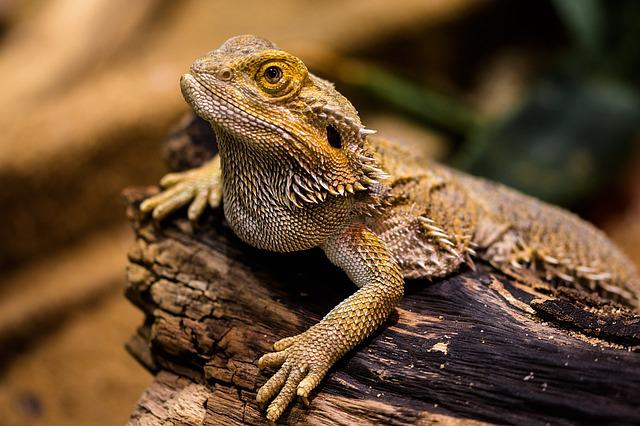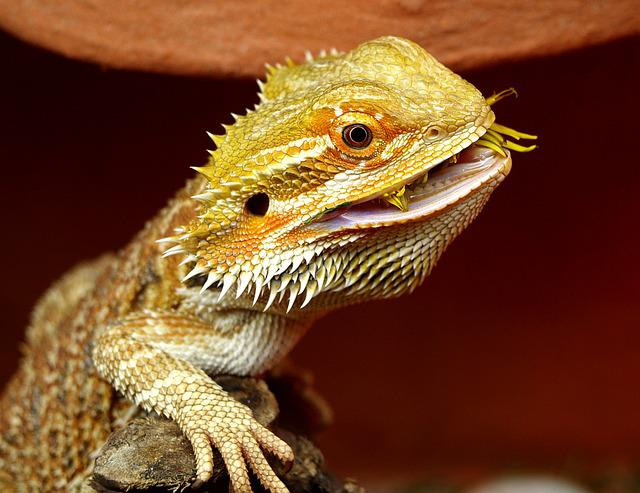Why is my bearded dragon digging? Many bearded dragon owners are stumped when they see their beloved pet start to dig. They may scratch at the ground, overturn rocks, and even tunnel into the substrate.
As any pet owner knows, our furry (or scaly) friends can sometimes do things that leave us scratching our heads in confusion. One such behavior is digging. Why do bearded dragons dig? Read on to find out!

Why Is My Bearded Dragon Digging?
There are a few reasons why your bearded dragon might be digging:
- One possibility is that they’re looking for food. Bearded dragons are native to Australia, where the climate is arid. In the wild, they would spend most of their time digging through the sand in search of insects or other small creatures to eat. While your bearded dragon probably isn’t hunting for their dinner, they may still dig holes in search for small objects to nibble on. Check your pet’s food dish to make sure they have enough to eat and that their diet is balanced and nutritious.
- Your bearded dragon might be digging to create a comfortable place to sleep, this is a natural behavior. Bearded dragons are reptiles, and like all reptiles, they are cold-blooded. This means that they rely on external sources of heat to regulate their body temperature, and a basking area helps to provide this important source of heat. If your home is too chilly for your lizard friend, they may dig a burrow in an attempt to find a warm spot or cooler spot. By digging a hole, your bearded dragon can ensure that its basking area is at the perfect temperature. Additionally, a basking area can also provide your bearded dragon with a sense of security. By being able to see what’s going on around them, they can feel more comfortable and less likely to be stressed. As a result, creating a basking area is an essential part of providing a healthy environment for your bearded dragon. To create a basking area, simply place a heat lamp over one end of the same enclosure. You can also use a basking rock or platform to provide a warm spot for your bearded dragon to relax. Just be sure that the basking area is not too hot, as this can cause your bearded dragon to become stressed. The ideal temperature for a basking area is between 95 and 105 degrees Fahrenheit. If you’re not sure whether or not your basking area is the correct temperature, you can use a thermometer to measure the temperature. By providing your bearded dragon with more space, you can help to keep them healthy, happy and stress-free.
Why Do Female Bearded Dragons Dig?

If you keep a female bearded dragon as a pet, you may notice that she frequently digs in her enclosure. This is perfectly normal behavior for a gravid (or pregnant) dragon and is caused by her instinct to find a suitable site to lay her eggs. Oncea female bearded dragon has found a spot that meets her requirements, she will excavate a small hole and deposit her eggs. Afterward, the female bearded dragon will carefully cover the eggs with soil and debris to protect them from predators and the elements. If you find that your bearded dragon is digging more than usual, it may be an indication that she is ready to lay eggs. In this case, it’s important to provide her with a “lay box” – a spot where she can lay her eggs safely. The lay box should be made of a non-toxic material such as vermiculite or sphagnum moss, and it should be large enough for your dragon to turn around comfortably. Once your bearded dragon lays eggs in the hiding spot, you’ll need to incubate them until they hatch. This process takes about 60 days.
Why Do Bearded Dragons Do Slow Head Bobbing?
If you’ve noticed your pet beardie doing the slow head bobbing, it’s a likely sign that they’re about to start digging excessively. In the wild, bearded dragons spend a lot of time basking in the sun on rocks or in trees. When they want to move to a new spot, they’ll often slow bob their head to first check that the coast is clear. If there are no predators around, they’ll quickly dart to their new basking spot. While your pet doesn’t have to worry about predators, the instinct to slow bob their head before moving is still there. So, if you see your bearded dragon slow bobbing its head, it’s a good indication that they’re getting ready to start digging.
Should I Be Worried That My Baby Bearded Dragon Does Slow Head Bobbing?
Bearded dragons are a type of lizard that is native to Australia. They are a popular choice for pets, due in part to their docile nature and relatively low maintenance requirements. Baby bearded dragons are particularly appealing, with their small size and cute appearance. If you’ve ever seen a baby bearded dragon, you may have noticed that they seem to move very slowly. This is due to their metabolism. Baby dragons are still growing and need time and enough space to adjust to their new environment. They are also trying to conserve energy so that they can grow as quickly as possible. One thing that you may also notice about your baby bearded dragons and other bearded dragon is this behavior. While it may look strange, this is a completely normal part of their development. head-bobbing helps many bearded dragons to learn about their surroundings and to communicate with other lizards. It also allows them to gauge the distance of potential prey items. So, if you see your baby bearded dragon slowly head-bobbing, don’t be alarmed.
How To Prevent My Bearded Dragon Digging Behavior?
A bearded dragon’s natural habitat consists of a lot of live bugs, rocks, plants, and open space. In the wild, female bearded dragons will often dig burrows to sleep in or to lay its eggs in. When setting up a bearded dragon’s tank, it is important to try to replicate their natural habitat as closely as possible. This means providing them with plenty of rocks, plants, and open space. It also means making sure the bearded dragon’s tank has a good drainage system to prevent water build-up. Bearded dragons dig when they feel that their tank is too wet or too cramped. If you notice your bearded dragon starting to dig, it is important to check the moisture levels in their tank and make sure they have enough space to move around. By replicating their natural habitat, you can help prevent your bearded dragon from feeling the need to start digging.
Conclusion
There can be several reasons why your bearded dragon is digging. It could be an instinct, the natural way to find both a basking area and egg-laying spot, or it could be a sign that something is wrong. If your dragon is displaying other abnormal behavior, it’s best to take them to the vet for a check-up. Otherwise, try providing them with more hiding places and substrates to dig in to see if that satisfies their urges.

